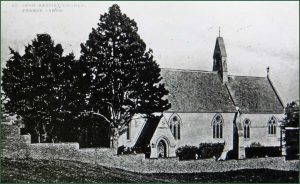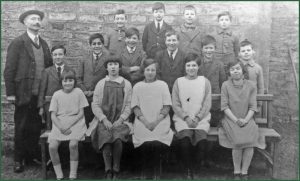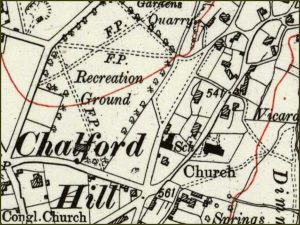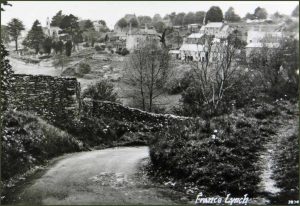France Lynch began as a collection of small stone cottages built as ‘overspill’ from Chalford Valley in the early 1600s. Families from the valley, who could find nowhere to live as the woollen mills expanded, migrated up the northern valley sides. These millworkers and weavers built the cottages along the spring line on the southern edges of Bisley Common. The cottages were collectively known as the “Lynches.” The dwellings in the area that became France Lynch gained a legitimacy denied to nearby similar collections of cottages in Oakridge Lynch and Chalford Hill/Lynch because of tacit recognition given by Sturmyes Manor Court in the integral hamlet of Avenis Green.
The area of what is now France Lynch and Avenis Green was initially known as Avenis Lynch. The name ‘France Lynch’ was only used regularly from about 1800, when surveys leading to the first 1828 Ordnance Survey map were initiated. It was at one time thought that the name ‘France’ related to the Huguenot weavers who once settled in the in the Stroud valleys (predominantly the Woodchester Valley) or perhaps that it was a corruption of ‘Frome’ from the nearby river. There is however now evidence that the name was derived from the ‘France Meeting’ which was the name taken by a group of nonconformist worshippers hounded out of the Chalford Valley in 1664.
After a long period of religious exile in Cowcombe Woods, a group of wealthy sympathetic clothiers built a chapel in 1697 on land at Starry Hill (now the cemetery at the junction of Keble Road and Coppice Hill) for these dissidents. One of the Clothiers, John Webb, also bought an adjacent smallholding and named it ‘France’ and then ‘France Farm’. Adjacent fields and buildings were named ‘France Ground’. The first known use of ‘France’ appears in 1725 in the deeds of this smallholding, now known as Woodlands House. Then in 1731 the Bisley Court records refer to ‘Ffrance Lynch’. The term ‘Lynch’ refers to the ridge of high land on which it is built. In earlier times the village had been part of the Tything of ‘Avenage’ in the parish of Bisley.
The larger and older houses in France Lynch were:
The Court House (or Webbs Court House) probably originated in the late 16th Century and the name relates to its function as the place where the tenants of nearby Sturmyes Manor or Court met. It is known that it passed into the hands of Stroud Brewery in 1885. At that time it was known as Webb’s Court House, referring to ownership by Samuel Webb of Avenis. The house was for many years an inn before reverting in 1955 to being the private residence it is today. There are, probably apocryphal, stories of gruesome executions at the Court House and joists in what was the beer cellar were said to be gallows.
Sturmy(e)’s Court (now Pontins Farm) was probably built in 1411. The house and surrounding estate were owned by the Sturmy family, who in the 1600s, as the Lynch Cottages were built, wrested Manor Rights from the Duke of Buckingham, then Lord of Bisley Manor. Although the records are destroyed Sturmye’s Court provided the “Court” functions of the southern part of the Bisley Parish. The Sturmye’s Manor Court and Estates were given or sold to the Bisley Feofees, an ancient charity whose responsibilities in 1742 included maintenance of the church and other Parish properties, together with education including payment of a schoolmaster. The house and estate were then sold to one James Ponting in 1733. The Ponting family subsequently pulled down the Manor and built a farm thereafter known as Ponting’s Farm, which remains in Avenis Green.
The Old Vicarage (at one time ‘France Grounds’) is an imposing building on Keble Road. Like many dwellings in France Lynch the deeds have vanished. It probably originated in the 17th Century as a small farm. It became known as France Ground in the early eighteenth century but was much extended by Edward Pyddoke, the first curate of St John’s, using his own considerable wealth. It is now in private hands.
The weavers
The principal occupation of village cottagers was weaving. They collected wool from the mills in Chalford Vale and wove it into cloth in their homes. There were also a few smallholdings. The former common was enclosed in 1869 bringing some benefits – the Pleasure Ground and allotments (“for the labouring poor”) – but denying villagers access to grazing land that had been particularly important for the donkeys, the predominant form of goods transport. The Curate of France Lynch (see below) led the opposition to the enclosures in support of donkey grazing against the powerful Sir John Dorrington, the local MP who subsequently lost his parliamentary seat over the controversy.
Places of Worship
Prior to 1695 All Saints Bisley was the only Church in the area. The France Meeting was one of the first dissenting groups in the county to build a place of worship, following the Toleration Act of 1689 that lifted the prohibition on non-conformist gatherings. The first Church built in 1695 was a round building. This was rebuilt in 1776 to accommodate more worshippers lower down the Starry Hill site and renamed France Chapel. Then in 1819 it moved to Chalford Hill as the France Congregational Chapel.
 For many years Anglican villagers walked two miles to the parish church at Bisley, although from the 18th century some walked down the hill to Christ Church chapel in Chalford. St John the Baptist Church was built in France Lynch during the incumbency of the Rev Thomas Keble at Bisley. The first curate, the Rev Edward Pyddoke, donated considerable sums towards the project. It was consecrated in 1857 when the population of France Lynch was around 550. The Church is famed among church architects for being the first full church designed by George Frederick Bodley. Bodley was a prolific English Gothic Revival Architect who went on to build the American National Cathedral in Washington.
For many years Anglican villagers walked two miles to the parish church at Bisley, although from the 18th century some walked down the hill to Christ Church chapel in Chalford. St John the Baptist Church was built in France Lynch during the incumbency of the Rev Thomas Keble at Bisley. The first curate, the Rev Edward Pyddoke, donated considerable sums towards the project. It was consecrated in 1857 when the population of France Lynch was around 550. The Church is famed among church architects for being the first full church designed by George Frederick Bodley. Bodley was a prolific English Gothic Revival Architect who went on to build the American National Cathedral in Washington.
Education

It is thought that there was an early ‘Dame School’ at Hap Cottage in Upper Lynch Road – Dame Schools were usually run by women in their homes.
The original France Meeting Chapel was used as a schoolroom when the new chapel was built in 1776, and much of the second chapel building continued as a Sunday School and then Day School until it was demolished.
Soon after that the France Lynch Church of England (National) School was built opposite the church, opening in in 1871. It ran successfully until the 1920s when there were unsatisfactory reports from HM Inspectors, and the number of children on the register declined. In 1931 the School Managers decided it was no longer viable, and it closed at Christmas. The ‘Church Rooms’ were bought by the Church from the Diocese for £650 in 1954 and are now used by the community.
Amenities and other interest points
The administrative and ecclesiastical history is reflected in the names of two roads winding through the village. The entrance road to the village takes the name of Thomas Keble and leads to Sturmyes Road, named after the Manor Court. Coppice Hill leading from France Lynch to Chalford Vale runs through an area of coppices of hazel planted by the farmers higher up the hill.
- A YMCA hut was erected on the recreation ground alongside Brantwood Road, where many village events ran until it was burnt down in the 1950s. On the map below it is between the ‘l’ and the ‘f’ in ‘Chalford’.

- In 1914 there were 3 pubs: The Wheatsheaf, the Kings Head and the Court House, and the France Lynch Post Office. This became the terminus for the first Motor Bus from France Lynch to Stroud.
- The France Lynch milkman, Mr. Jones, died in a blizzard outside ‘Laregan’ in March 1916.
- The village was late in being connected to the utilities (Gas 1936; Electricity 1938)
- The water mains were laid by German POW’s in 1947 – before this Walter Gibbins of France Lynch was employed as water diviner to locate wells.

